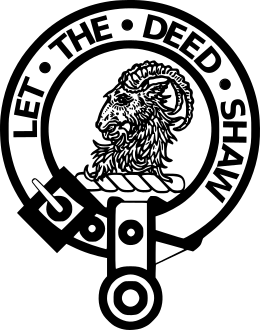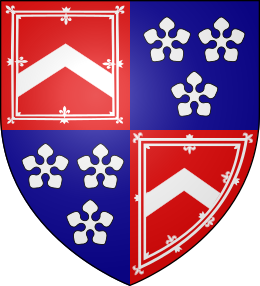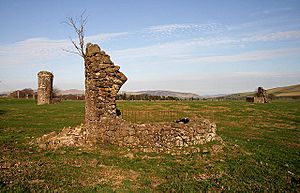Clan Fleming facts for kids
Quick facts for kids Clan Fleming |
|||
|---|---|---|---|

Crest: A goat's head erased Argent, armed Or
|
|||
| Motto | Let The Deed Shaw | ||
| Profile | |||
| Region | Lanarkshire | ||
| Plant badge | None | ||
 |
|||
| Clan Fleming has no chief, and is an armigerous clan | |||
| Historic seat | Cumbernauld Castle | ||
| Last Chief | Charles Fleming, The 7th Earl of Wigtown | ||
| Died | 1747 | ||
|
|||
|
|||
Clan Fleming is a historic Scottish clan from the Lowlands. It is officially recognized as a clan by the Lord Lyon King of Arms, who is in charge of Scottish coats of arms and genealogies. However, because the clan does not currently have a chief who is recognized by the Lord Lyon, it is known as an armigerous clan. This means it once had a chief but does not have one today.
Contents
History of Clan Fleming
Where Did the Flemings Come From?
The name Fleming comes from the French phrase le Fleming. This means "the man from Flanders". Flanders was a powerful region in medieval times. Today, parts of Flanders are in Belgium, the Netherlands, and France.
In the late 1100s, people from Flanders were skilled merchants. They traded a lot with England, Scotland, and Wales. A well-known Flemish leader named Baldwin moved to Biggar, South Lanarkshire in Scotland. He brought his followers with him. King David I of Scotland gave them land. Baldwin became the Sheriff of Lanark, an important local official. This job seemed to stay in his family for a while.
Fighting for Scottish Independence
In 1296, nine Flemings signed the Ragman Rolls. This document meant they promised loyalty to King Edward I of England. However, one of them, Sir Robert Fleming, quickly joined Robert the Bruce. Bruce was fighting for Scotland's freedom after the death of Comyn in 1306.
In 1342, Sir Malcolm Fleming of Cumbernauld was made the Earl of Wigtown. King David II of Scotland gave him this title. It was a reward for helping to protect the king from Edward Balliol and the English. Later, in 1371, Sir Malcolm's grandson, Thomas Fleming, sold the earldom. It was bought by Archibald Douglas. King Robert II of Scotland approved this sale.
The Flemings in the 1400s
Sir Malcolm Fleming of Biggar and Cumbernauld was made a knight by King Robert III of Scotland. In 1423, he was one of the important people given as a hostage. This was to help free King James I of Scotland from being held captive by the English.
This Sir Malcolm Fleming was a close friend and advisor to William Douglas, 6th Earl of Douglas. In November 1440, he went to Edinburgh Castle with Douglas. They were invited by Governor Livingstone and Chancellor Crichton. But when they arrived, Douglas, his brother David, and Fleming were arrested. They were quickly put on trial and then executed. Because of this, Sir Malcolm's younger son, Sir Robert Fleming, lost his lands. However, King James II of Scotland later returned them. Sir Robert Fleming was made a Lord of Parliament before 1460.
The Flemings in the 1500s
Sir Robert's grandson, John Fleming, 2nd Lord Fleming, became a guardian for young King James V of Scotland in 1515. In 1517, John also became the Lord Chancellor of Scotland, a very high position. Sadly, on November 1, 1524, he was killed while out hawking. He was assassinated by John Tweedie of Drummelzier, who was the chief of Clan Tweedie, and others.
Malcolm Fleming, 3rd Lord Fleming, was the Chamberlain of Scotland, another important role. He married Lady Janet Stewart, who was the daughter of King James IV of Scotland. This Malcolm Fleming was killed in a battle called the Battle of Pinkie Cleugh in 1547.
In 1548, James Fleming, 4th Lord Fleming, traveled with the young Mary, Queen of Scots to France. She went there to marry the French prince. James was the Great Chamberlain of Scotland for life. He was also one of eight people chosen to attend the royal wedding in 1558. However, he died just two weeks later in Paris, possibly from poisoning.
The Flemings in the 1600s
In 1606, John, the sixth Lord Fleming, was given the title of Earl of Wigtown.
The Flemings in the 1700s and Jacobite Risings
The Clan Fleming supported the Jacobites. These were people who wanted the old royal family, the Stuarts, to be kings of Scotland and England again. The 6th Earl of Wigtown supported King James II and VII after the Glorious Revolution of 1688. This event saw James II lose his throne.
Fleming was against the Treaty of Union. This treaty joined Scotland and England into Great Britain. He voted against every part of it in the Parliament of 1706. During the Jacobite rising of 1715, he was arrested by the governor of Edinburgh Castle. Charles Fleming later became the earl after his brother. When he died in 1747, the title of Earl of Wigtown became "dormant." This means there was no one left to inherit it.
Famous Flemings in Modern Times
One of the most famous people with the Fleming name in recent history is Alexander Fleming. He was the scientist who discovered Penicillin, a very important medicine.
Clan Castles
The Clan Fleming owned several castles over the years. Here are some of them:
- Biggar Castle: This strong castle was once on the High Street of Biggar, South Lanarkshire. It dated back to the 1200s. Nothing is left of it today. The Flemings, who were descendants of Baldwin of Biggar, owned it for a long time. They later moved to Boghall Castle in the 1300s.
- Boghall Castle: This castle is on the south side of Biggar, Lanarkshire. Most of it was built in the 1500s, but there was an older fort there before. Only two D-shaped towers remain, and the rest is in ruins. King Edward II of England stayed at Boghall in 1310.
- Cumbernauld Castle: Located in Cumbernauld, central Scotland, this was a very strong castle. Most of it is now gone. Only the vaulted rooms and some other parts remain. These parts are now built into Cumbernauld House. The castle was first owned by the Clan Comyn. It passed to the Flemings in 1306. Mary, Queen of Scots visited the castle. The National Covenant was signed there in 1646. The castle was burned down in 1746 by government soldiers during the Jacobite rising of 1745.


